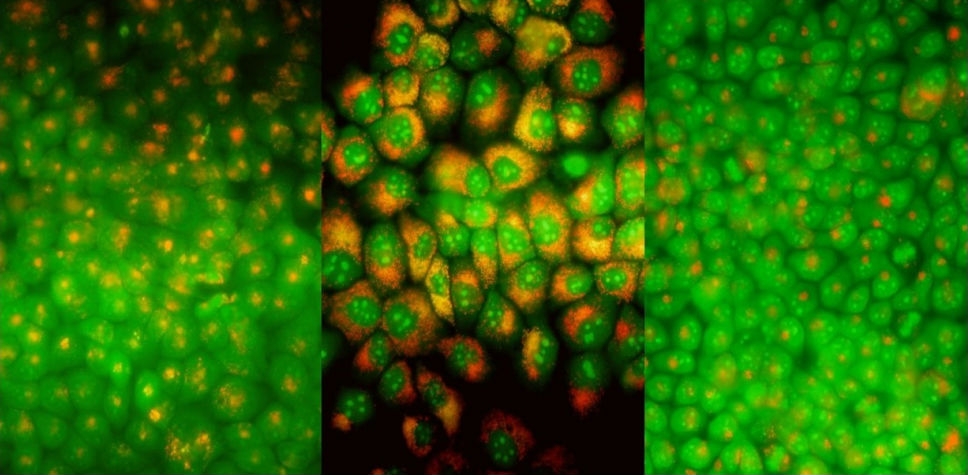

From left to right: Human cells treated with a non-specific photosensitizer; cultured cells treated with pigment that causes parallel damage to the membranes of lysosomes and mitochondria; control culture (image: WK Martins et al / Autophagy)
A discovery by scientists affiliated with a research center supported by FAPESP could contribute to the development of more powerful photosensitizers. When these molecules are exposed to light, they trigger biochemical processes that lead to the disruption of the cell membranes of tumors or pathogens.
A discovery by scientists affiliated with a research center supported by FAPESP could contribute to the development of more powerful photosensitizers. When these molecules are exposed to light, they trigger biochemical processes that lead to the disruption of the cell membranes of tumors or pathogens.

From left to right: Human cells treated with a non-specific photosensitizer; cultured cells treated with pigment that causes parallel damage to the membranes of lysosomes and mitochondria; control culture (image: WK Martins et al / Autophagy)
By André Julião | Agência FAPESP – The findings of a study reported in the Journal of the American Chemical Society can enhance the effectiveness of the techniques used in photodynamic therapy, a medical treatment in which a medication, when exposed to light, triggers biochemical processes that puncture the membranes of target cells.
Conducted in Brazil by researchers affiliated with the Center for Research on Redox Processes in Biomedicine (Redoxome), the study showed that the degradation of the photosensitizer (the molecule used to make cells more light-sensitive) is a key element in the medication’s action mechanism. Previously, it was believed that degradation by light (photobleaching) must be avoided to ensure photosensitizer effectiveness.
Redoxome is a Research, Innovation and Dissemination Center (RIDC) funded by FAPESP and hosted by the University of São Paulo’s Chemistry Institute (IQ-USP).
To reach the findings described in the article, the researchers developed a set of light-sensitive organic pigments called porphyrazines with the aim of investigating the processes induced by these molecules in cell membranes exposed to light.
All the porphyrazines used in the study were capable of producing the same amount of singlet oxygen, an electronically excited species of the oxygen molecule known to disrupt light-exposed cell membranes through oxidation. The researchers were therefore able to focus on other processes that caused cell damage and were induced by the pigments.
“We found that as well as acting as photosensitizers via the well-known singlet oxygen production mechanism, porphyrazines also act as oxidizing agents by contact reaction, removing electrons directly from lipids’ double bonds. The outcome of these reactions is the formation of free radicals, which oxidize cell membrane lipids and produce more damage, boosting their effect,” said Thiago Teixeira Tasso, first author of the article. The study was conducted during Tasso’s postdoctoral internship at IQ-USP, supported by FAPESP. He is currently a professor at the Federal University of Minas Gerais’s Institute of Exact Sciences (ICE-UFMG).
In a previous study, a group led by Mauricio da Silva Baptista, a professor at IQ-USP and a coauthor of the article, showed that a key factor in the production of irreversible damage to cell membranes was the formation of lipid aldehydes, which open pores in the external structure of cells and lead to extrusion of their contents (read more at: agencia.fapesp.br/29698).
“The discovery has the potential to change the paradigm that photosensitizer degradation is undesirable because of a reduction in efficacy,” Baptista said. “In our study, we observed that, depending on the molecule, this photobleaching can be beneficial and increase membrane damage.”
The study was conducted as part of the project “Photosensitizers: from fundamental properties to biological applications”, supported by FAPESP. The principal investigator for the project is Paula Homem-de-Mello, a professor in the Center for Natural and Human Sciences at the Federal University of the ABC (CCNH-UFABC) in São Paulo State.
Membrane destruction
For some years, the group at IQ-USP has been investigating mechanisms that damage the cell membrane and lead to cell death, aiming to contribute to the development of more efficient photosensitizers (read more at: agencia.fapesp.br/20826 and agencia.fapesp.br/26757).
In this latest study, the researchers compared two porphyrazine-based photosensitizers with similar photophysical properties but different degrees of susceptibility to photobleaching.
In two models designed to simulate the cell membrane in vitro (using substances found in actual human cells), they found that the speed at which pores formed in the membrane was proportional to the rate of photobleaching. This result occurred because when a photosensitizer is exposed to light, it extracts electrons from the double bond in the membrane lipids, and the membrane is disrupted as a result.
“We proved that photobleaching is actually important, although it has always been avoided by anyone who synthesizes this type of molecule. It shouldn’t be avoided. Instead, preference should be given to molecules that degrade more, reapplying them whenever necessary,” Baptista said.
The researchers are now performing in vivo tests of the photosensitizers used in the study to see how they affect human cells. If they obtain the same results, the molecules may next be tested in animals.
The article “Photobleaching efficiency parallels the enhancement of membrane damage for porphyrazine photosensitizers” (doi: 10.1021/jacs.9b05991) by Thiago T. Tasso, Jan C. Schlothauer, Helena C. Junqueira, Tiago A. Matias, Koiti Araki, Érica Liandra-Salvador, Felipe C. T. Antonio, Paula Homem-de-Mello and Mauricio S. Baptista can be retrieved from pubs.acs.org/doi/10.1021/jacs.9b05991.
Republish
The Agency FAPESP licenses news via Creative Commons (CC-BY-NC-ND) so that they can be republished free of charge and in a simple way by other digital or printed vehicles. Agência FAPESP must be credited as the source of the content being republished and the name of the reporter (if any) must be attributed. Using the HMTL button below allows compliance with these rules, detailed in Digital Republishing Policy FAPESP.





